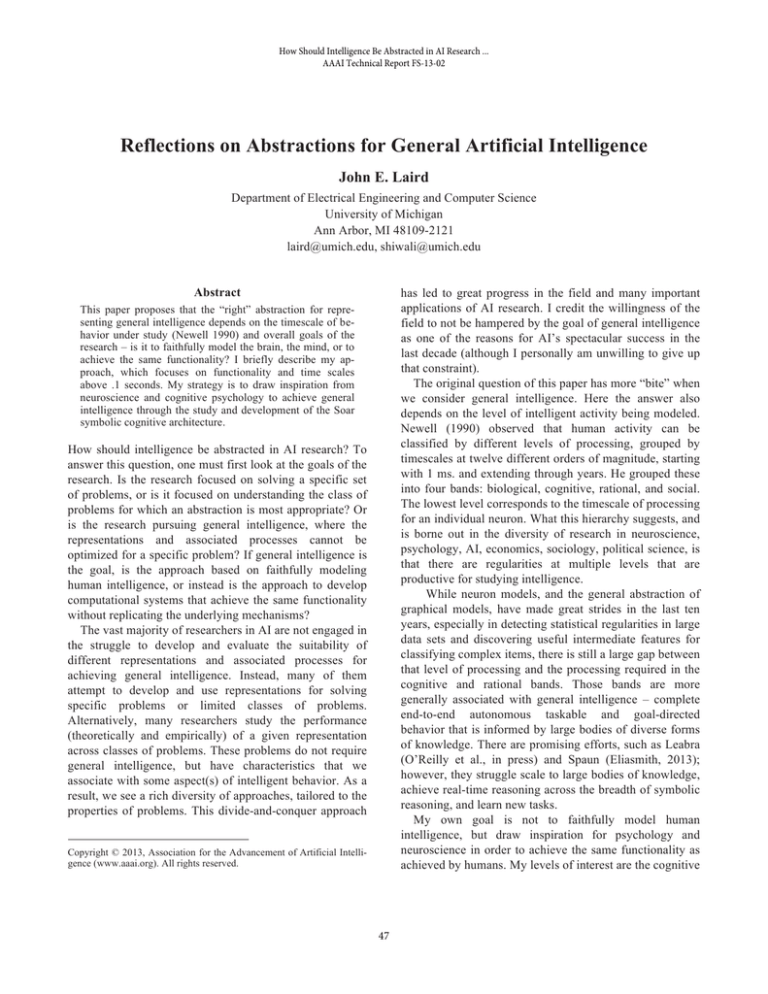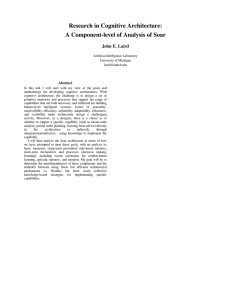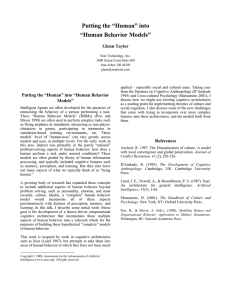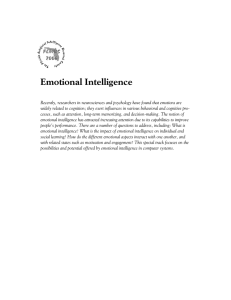
How Should Intelligence Be Abstracted in AI Research ...
AAAI Technical Report FS-13-02
Reflections on Abstractions for General Artificial Intelligence
John E. Laird
Department of Electrical Engineering and Computer Science
University of Michigan
Ann Arbor, MI 48109-2121
laird@umich.edu, shiwali@umich.edu
Abstract
has led to great progress in the field and many important
applications of AI research. I credit the willingness of the
field to not be hampered by the goal of general intelligence
as one of the reasons for AI’s spectacular success in the
last decade (although I personally am unwilling to give up
that constraint).
The original question of this paper has more “bite” when
we consider general intelligence. Here the answer also
depends on the level of intelligent activity being modeled.
Newell (1990) observed that human activity can be
classified by different levels of processing, grouped by
timescales at twelve different orders of magnitude, starting
with 1 ms. and extending through years. He grouped these
into four bands: biological, cognitive, rational, and social.
The lowest level corresponds to the timescale of processing
for an individual neuron. What this hierarchy suggests, and
is borne out in the diversity of research in neuroscience,
psychology, AI, economics, sociology, political science, is
that there are regularities at multiple levels that are
productive for studying intelligence.
While neuron models, and the general abstraction of
graphical models, have made great strides in the last ten
years, especially in detecting statistical regularities in large
data sets and discovering useful intermediate features for
classifying complex items, there is still a large gap between
that level of processing and the processing required in the
cognitive and rational bands. Those bands are more
generally associated with general intelligence – complete
end-to-end autonomous taskable and goal-directed
behavior that is informed by large bodies of diverse forms
of knowledge. There are promising efforts, such as Leabra
(O’Reilly et al., in press) and Spaun (Eliasmith, 2013);
however, they struggle scale to large bodies of knowledge,
achieve real-time reasoning across the breadth of symbolic
reasoning, and learn new tasks.
My own goal is not to faithfully model human
intelligence, but draw inspiration for psychology and
neuroscience in order to achieve the same functionality as
achieved by humans. My levels of interest are the cognitive
This paper proposes that the “right” abstraction for representing general intelligence depends on the timescale of behavior under study (Newell 1990) and overall goals of the
research – is it to faithfully model the brain, the mind, or to
achieve the same functionality? I briefly describe my approach, which focuses on functionality and time scales
above .1 seconds. My strategy is to draw inspiration from
neuroscience and cognitive psychology to achieve general
intelligence through the study and development of the Soar
symbolic cognitive architecture.
How should intelligence be abstracted in AI research? To
answer this question, one must first look at the goals of the
research. Is the research focused on solving a specific set
of problems, or is it focused on understanding the class of
problems for which an abstraction is most appropriate? Or
is the research pursuing general intelligence, where the
representations and associated processes cannot be
optimized for a specific problem? If general intelligence is
the goal, is the approach based on faithfully modeling
human intelligence, or instead is the approach to develop
computational systems that achieve the same functionality
without replicating the underlying mechanisms?
The vast majority of researchers in AI are not engaged in
the struggle to develop and evaluate the suitability of
different representations and associated processes for
achieving general intelligence. Instead, many of them
attempt to develop and use representations for solving
specific problems or limited classes of problems.
Alternatively, many researchers study the performance
(theoretically and empirically) of a given representation
across classes of problems. These problems do not require
general intelligence, but have characteristics that we
associate with some aspect(s) of intelligent behavior. As a
result, we see a rich diversity of approaches, tailored to the
properties of problems. This divide-and-conquer approach
Copyright © 2013, Association for the Advancement of Artificial Intelligence (www.aaai.org). All rights reserved.
47
and rational bands, spanning activity from approximately
.1 sec. to hours. These are the levels that have been studied
by much of the traditional research in AI, covering reactive
behavior, goal-directed decision making, natural language
processing, planning, and so on. Fundamental to these
levels is the assumption that the abstraction afforded by
symbol systems captures the essential capabilities required
for human-level intelligence (Newell 1990), while
abstracting away from the lower levels and the details of
the underlying technology. Within research focused on
these levels, the subfield of symbolic cognitive
architectures has arisen (Langley, Laird, and Rogers 2009),
whose goal is to create generally intelligent real-time
agents, with end-to-end (usually embodied) behavior. By
focusing on architecture, we study both individual
components and their integration.
There are currently many different symbolic cognitive
architectures (e.g., ACT-R, CogPrime, ICARUS, LIDA,
Polyscheme, and Soar). Across those architectures, there
are two shared representational commitments. The first is
that relational symbolic structures are used for an agent’s
internal representation of the current situation. The second
is that non-symbolic representations influence knowledge
retrieval and decision making, as well as being the basis
for perceptual processing and motor control.
As an example, Figure 1 shows the structure of the Soar
cognitive architecture (Laird 2012). Symbolic structures
are extracted from perception, and added to the symbolic
working memory. Symbolic representations are also used
for procedural knowledge (production rules), and longterm declarative knowledge (semantic and episodic). Soar
accesses its procedural knowledge by matching the
conditions of rules to working memory, and firing all rules
that match. Decision making is based on preferences
retrieved from procedural memory, and those preferences
can be symbolic (A > B), but they can also be numeric
quantities that represent the expected values of proposed
operators. These expected values are automatically updated
by reinforcement learning as an agent interacts with its
environment. Data from long-term declarative memories is
retrieved by the creation of symbolic cues which are
matched to the contents of the memory, biased by numeric
activations. Activation information is also maintained for
working memory and is used to support forgetting.
Soar’s perception system includes a mental imagery
component (called SVS), which uses a scene graph to
represent perceived and imagined objects, and associated
spatial metric information. Soar agents can extract
symbolic spatial relations from SVS, as well as project
objects into SVS where the agent can perform nonsymbolic spatial reasoning operations, such as imagining
the path of an object and detecting if it would collide with
other objects in the environment.
Symbolic Long-Term Memories
Procedural
Reinforcement
Learning
Semantic
Chunking
Semantic
Learning
Episodic
Episodic
Learning
Appraisals
Perceptual STM
Perception
Decision
Procedure
Symbolic Working Memory
Perceptual LT Memory
Mental Imagery
Action
Body
Figure 1. The structure of the Soar.
Using Soar, we have developed agents that embody
many capabilities associated with intelligence.1 The most
advanced agent in terms of the combinations and
2
integration of features is Rosie, an agent learns from
situated interactive instruction (Mohan et al. 2012; Mohan,
Kirk, and Laird 2013). The agent is embodied with a
Kinect sensor and a robotic arm, and manipulates foam
blocks. The agent starts with procedural knowledge for
general language processing, instruction interpretation and
learning, dialog management, and performing primitive
actions (pickup and putdown), and some limited
declarative knowledge of locations in its world. Using
interactive instruction, Rosie learns new nouns/adjectives
(relating to color, size, and shape), prepositions (relating to
spatial relations), and verbs (compositions of the primitive
actions). After learning, Rosie can describe object
properties and their spatial relations, and execute the
learned verbs. Moreover, the learned words can be used in
future instructions and interactions with the agent. In
addition, Rosie can learn new tasks, which it then solves
using its robotic arm. For example, in learning Towers of
Hanoi, a human instructor describes the spatial relations,
actions, and goal for Towers of Hanoi. Following
instruction, the agent solves the problem internally using
iterative deepening, and then executes the solution by
moving blocks.3 The agent learns semantic, procedural,
and episodic knowledge, and uses mental imagery for
internally projecting the actions. To date, Rosie has been
taught ten different games and puzzles and is able to
1
See Laird, (2012) for an analysis of the requirements I associate with
intelligence and for an evaluation of how well Soar supports them.
2
RObotic Soar Instructable Entity.
3
The robot does not have the dexterity to stack disks on pegs, so we teach
it an isomorphism of the puzzle that involves stacking blocks in three
towers.
48
Langley, P., Laird, J. E., and Rogers, S. (2009). Cognitive
architectures: Research issues and challenges. Cognitive Systems
Research, 10 (2).
transfer knowledge learned in one to others that use the
same concepts.
Our continued success in extending Soar and using it to
create agents that embody many of the capabilities we
associate with intelligence makes me optimistic that
symbolic systems are an appropriate abstraction for
achieving general intelligence. However, I see the value in
the capabilities of graphical architectures, and there is
always the chance that symbolic architectures will fail to
capture some aspects of intelligence that require a lower
level of abstraction. Thus, one interesting line of research
is to consider how cognitive architectures can be realized
in lower-level abstractions, such as graphical models and
neural networks. This is the line of research being pursued
with Sigma, which is a graphical-model architecture
inspired by Soar (Rosenbloom 2013), and SAL (Jilik et al.
2008), which integrates ACT-R and Leabra.
My current hypothesis is that neural/graphical models
are necessary for modeling perception and some aspects of
motor control, but that symbolic representations,
augmented with non-symbolic metadata (such as activation
or appraisals) for biasing retrieval and decision making, are
sufficient for achieving the breadth we see in general
intelligence. They also are much easier to work with, more
efficient, and can scale to very large bodies of knowledge.
In terms of functionality, the symbol structures make it
possible for Rosie to learn completely new tasks from
natural language instruction – not just new policies as in
reinforcement learning, but the set of available actions,
goal conditions, and constraints that define a task. After
learning a task, Rosie can solve it (through internal search)
and transfer some of what it learned to new tasks. This
ability of cognitive taskability appears to be a major
strength of the cognitive architecture approach, but remains
a challenge for other approaches.
As it is, I have not experienced sufficient shortcomings
in our development and use of Soar to lead me to consider
lower-level alternatives. There needs to be compelling
functionality that arises from a lower-level of abstraction
(without sacrifice of functionality or computational
efficiency) before I will make a shift in my overall
approach to modeling intelligence through symbolic
cognitive architecture.
Mohan, S., Mininger, A., Kirk, J., & Laird, J. (2012). Acquiring
grounded representations of words with situated interactive
instruction. Advances in Cognitive Systems, 2012.
Mohan, S., Kirk, J., & Laird, J. (2013). A computational model
for situated task learning with interactive instruction,
International Conference on Cognitive Modeling, 2013.
Newell, A. (1990). Unified Theories of Cognition. Harvard University Press.
O'Reilly, R.C., Hazy, T.E. & Herd, S.A. (in press). The Leabra
cognitive architecture: How to play 20 principles with nature and
win! S. Chipman (Ed.) Oxford Handbook of Cognitive Science,
Oxford: Oxford University Press.
Rosenbloom, P. S. (2013). The Sigma cognitive architecture and
system. AISB Quarterly, 136, 4-13.
References
Eliasmith, C. (2013). How to Build a Brain. Oxford: Oxford
University Press.
Jilk, D. J., Lebiere, C., O'Reilly, R.C., and Anderson, J. R.
(2008).
SAL:
an
explicitly
pluralistic
cognitive
architecture. Journal of Experimental and Theoretical Artificial
Intelligence 20, 3.
Laird, J. E. (2012). The Soar Cognitive Architecture. MIT Press.
49




